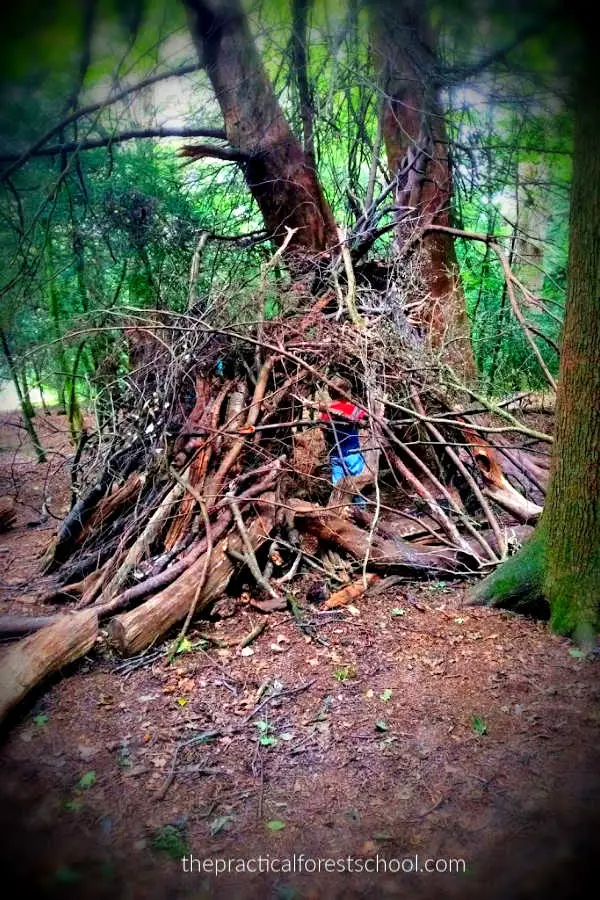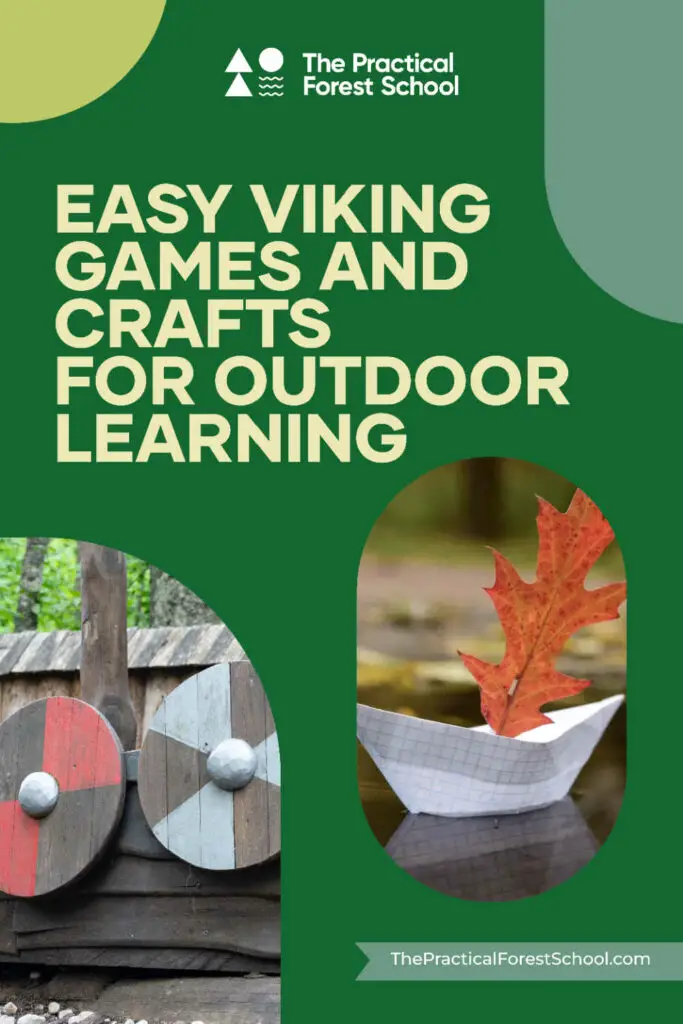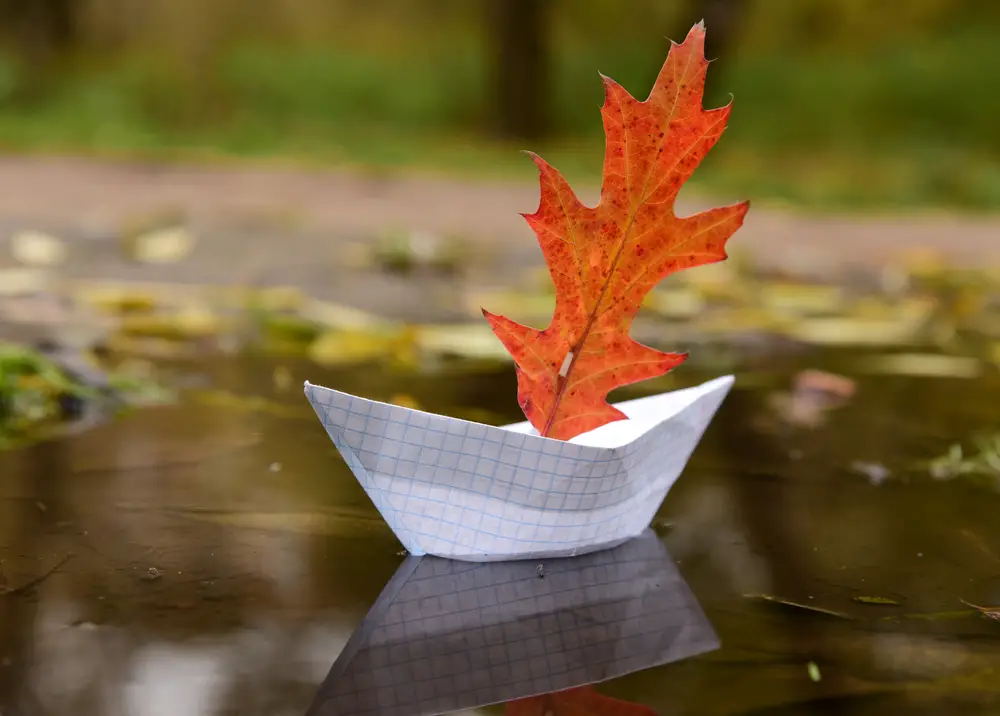Exploring Viking Culture with Forest School Viking Ideas
If you’re looking for forest school viking ideas, then look no further! Viking culture is a fascinating topic to explore with children and there are plenty of activities that can help bring it alive.
From outdoor games inspired by the Vikings to crafting projects, storytelling sessions and more – this blog post will provide some great inspiration on how to introduce your students or young learners to these legendary seafarers in an engaging way.
I know, I know, forest school is not curriculum-led. However, many of our readers work in outdoor learning roles, and I’m an Outdoor TA in one school.
Schools can implement outdoor experiences in a variety of ways, and often forest school leaders working in schools are asked to weave the curriculum into their sessions.
So if this term your class is doing Vikings, here’s how to translate that to the great outdoors.
Outdoor Activities Inspired by Vikings
Shelter building
We love making a good shelter. Building shelters in the woods is an activity that will help them understand how Viking settlers lived and worked. The children can use natural materials such as sticks, leaves, and mud to construct their own shelter or recreate a traditional Viking longhouse.
If you don’t have time (or the materials) to make full-sized shelters, invite the children to create models instead.

Foraging
Foraging for food like Vikings did is another fun outdoor activity that teaches kids about the importance of gathering wild plants and berries for sustenance. This could involve going on a nature walk to identify edible plants or creating a scavenger hunt with clues leading to different types of food sources.
Warning: You’ll need a risk assessment and a fair bit of adult supervision if you’re taking kids foraging. Just think through the implications of this before you plan out the session. Perhaps identify the plants but don’t eat them, or bring an experienced foraging expert to your setting to lead the session in an age-appropriate way.
Navigation and map-making
We do quite a lot of navigation-based outdoor activities in school because map-reading and orienteering is on the curriculum. Why not teach it with a Viking theme?
Going on an adventure with a map and compass is an exciting way to explore the outdoors while learning about Viking navigation techniques. Kids can practice orienteering skills by following directions on a treasure map or creating their own maps based on what they observe in nature around them.
Our children loved using cold tea to dye paper to make it look old. I did this as a child too and I wasn’t expecting them to love it so much because I’ve done it so many times it’s not personally exciting any longer! But to see them light up when they realised the transformation, comparing the different dyes (we used tea and coffee)… they were super engaged with it.
Then we lit candles and they carefully charred the edges of their treasure maps for extra oldness. Again – what child isn’t mesmorised by a candle?
This is a great exercise to do outside. We used a roasting tin to dip the paper in and then hung them up to dry which didn’t take long. Later, we returned to the sheets to burn the edges and decorate them with the treasure directions.
Encouraging children to take risks (not the ‘eat a plant I’ve found and see what happens’ kind of risk though) and think outside the box when it comes to problem-solving will help them develop important life skills while having fun outdoors.
Viking-themed games
Viking ship races
This game is a great way to get children engaged in learning about Viking culture and history. It requires two teams of players, each with their own “ship” (a large blanket or tarp). The goal is for the teams to race across the area while staying on their ship. To make it more challenging, you can add obstacles such as chairs or hula hoops that they must navigate around. Can they work as a team to cross the ocean?
You can play this indoors or outside, but if you’re doing it outdoors I recommend a field or playground rather than a woodland as that will make it safer underfoot. It opens up opportunities for discussions about where the Vikings were going, why and what they did when they got there (keep this age-appropriate!).
Viking tag
A classic game with a twist! In this version of tag, one player is designated as the Viking and all other players are villagers trying to avoid being caught by the Viking.
If a villager gets tagged by the Viking, they become part of his or her crew and help him catch other villagers until everyone has been caught. This would be a good warm up activity if you’re working outside on a cold day.
Hide-and-seek Vikings
In this variation of hide-and-seek, one player hides while the others count from 1 to 10 in Old Norse numbers (eitt – tíu: maybe use a prior learning experience to research and practice these numbers before the game).
When found, each hidden player must give up a treasure such as coins or candy before rejoining the group. Remember to give out the sweets before they hide!
You do need quite a large area for hide-and-seek, with enough things to hide behind. This game would work well in your forest school area – it’s not so good on a bare playground!

Viking-themed crafts
Make a shield
Making Viking shields is a great way to explore the culture of Vikings with children. It’s an activity that can be done indoors or outdoors, and it requires only basic materials such as cardboard, paint, glue, and string.
To make a shield, start by cutting out a circle from the cardboard. Then use paint to decorate it with symbols or designs inspired by Viking shields. Once dry, attach two pieces of string on either side for straps so that the child can wear their shield like a backpack!
Mini-longships
Constructing longships on minature scale is something else worth doing. Make paper boats or do what we do: find the biggest leaf you can and use that. Our preschoolers have also been known to float cream cheese tubs, anchovy tins and other packaging: they all make a great “longship” starter that can be adapted and decorated with whatever natural materials you can find.
Have fun sailing these homemade boats across any nearby body of water; streams and puddles are great. Give each child a straw if you want to turn it into a race: have them blow their boats between two points.

Ditch the idea of making horned helmets. Real Viking helmets didn’t have horns. While they look great in books and on TV, they weren’t really part of Viking culture.
Exploring Viking culture
The Vikings were a seafaring people who lived in Scandinavia from the 8th to 11th centuries. They are known for their daring explorations, raids, and trading expeditions. You can take the culture outdoors by sharing stories and history with the children. Here are a couple of examples.
Learning about Norse mythology
Norse mythology is filled with tales of gods, goddesses, giants, dwarfs, and other mythical creatures. These stories provide insight into the beliefs of the Vikings and how they viewed the world around them.
Teaching these stories can help bring ancient cultures alive for young learners while also helping them understand why certain customs or practices may have been important to those living during that time period.
I would get a book out of your local library or take one from the school library. There are plenty of age-appropriate stories to share.
Studying the history of vikings
Have you been asked to weave some history and geography into your sessions?
You can start by looking at their exploration routes throughout Europe and beyond, examining artifacts such as weapons or jewelry found on archaeological sites (perhaps replicating a picture you have found in natural materials?), discussing how trade impacted their society (set up some ‘trading posts’ and have the kids run around seeing what they can ‘buy’) or researching how Christianity changed life for many Scandinavian people over time.
Investigating Viking artifacts
Examining artifacts associated with Viking culture can be a great way for kids to learn more about this era in history without having access to actual historical sites or museums dedicated solely to this topic.
Have a browse through the British Museum’s online collection of Viking artifacts and see if there are any items you could link to your session.
Common items include tools used by craftsmen like blacksmiths, pottery pieces decorated with intricate designs, coins used during trade transactions, jewellry made from precious metals like gold or silver, religious objects such as crucifixes or amulets worn by Christian converts, clothing items made from woolen fabrics dyed bright colors using natural dyes derived from plants found in Scandinavia’s forests and meadows – all providing clues into what life was like during this time period.
Turn these into activities by inviting the children to dig for hidden pottery or coins (which you would have to hide first unless you’re confident they will find something!). Have a go at creating natural dyes from blackberries, nettles or other plants available in your settings and painting on plain cotton.
Storytelling and role-playing with Vikings as the theme
If you are the kind of forest school leader or outdoor education lead that brings story telling and role-playing to their sessions, then this one is for you.
Creating characters based on Norse legends is an excellent way for kids to explore Viking stories. They can create their own characters based on gods or goddesses from the myths, or they can choose one of the more well-known figures like Thor or Odin.
Once they have chosen their character, they can use props such as shields and swords to act out scenes from the legends. This would be good to do on a day where they’ve come into school dressed up, because we have to have a themed non-uniform day, right?
Writing stories about Vikings and their adventures encourages creative thinking skills while teaching kids about Norse mythology. Children could write stories that involve gods battling giants or brave warriors setting off on epic quests. Not so easy to do outside, but if you’re looking for indoor Viking activities, it’s a winner. You can always take their stories outside to act out in groups.
Acting out scenes from Norse myths is an excellent way for kids to explore Viking culture through role-playing activities. They can act out battles between Thor and Loki (carefully), recreate famous events such as Ragnarok (the end of the world), or even create their own adventures featuring characters from these tales. The possibilities are endless; all that is required is a bit of imagination.
I’d say it’s important to give them some guidance when it comes to researching facts so that their stories are accurate but still entertaining! Otherwise their stories might have helmets with horns on!
Got a question?
What are some of the most popular forest school viking activities?
Popular activities include orienteering, shelter building, fire lighting and cooking over an open fire. Bushcraft skills such as knot tying, tool use and natural crafts can also be incorporated into the program. Forest school viking activities are popular among forest school leaders, early years educators and primary school educators, because they link to curriculum objectives. These activities often involve outdoor exploration, problem solving and team building, just like the Vikings would have done.
How can I incorporate traditional Viking culture into my forest school sessions?
Viking culture can be incorporated into forest school lessons in a variety of ways. For example, you could introduce stories and legends from Norse mythology to spark discussion and imagination.
You could also explore Viking history by looking at archaeological evidence such as artifacts or rune stones. Additionally, you could have students create their own Viking-inspired crafts like shields or wooden boats.
Finally, outdoor activities such as archery or fire building can help bring the culture to life in an engaging way for learners of all ages.
What safety considerations should be taken when introducing Viking-inspired activities to a forest school setting?
When introducing Viking-inspired activities to a forest school setting, safety should be the top priority. Plan ahead, and make sure activities are suitable for the age group (no axe throwing!).
It is important to ensure that children are adequately supervised, and complete a risk assessment. Finally, be prepared for any unexpected events or changes in weather conditions by having an emergency plan in place.
Will you try these activities?
I hope that these forest school viking ideas have inspired you to create fun and engaging activities for your students. Whether it’s playing Viking games, creating crafts, exploring the culture or participating in outdoor activities based on the Vikings, there are plenty of ways to bring this topic alive.
Get in touch with us via our Facebook page and share what you have done on this topic.

About the author: Jon Borley
Jon qualified as a Level 3 Forest School Leader with the Sussex Wildlife Trust. He works independently as a practitioner running forest school clubs and also within schools both in a forest school capacity and as an outdoor learning teaching assistant, working with preschoolers to secondary-aged children. He has previously led sessions for adults as part of professional development events for the Sussex FSA, and is a member of MIAS.